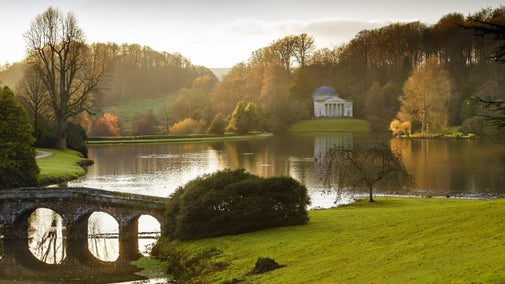
Discover more at Stourhead
Find out when Stourhead is open, how to get here, the things to see and do and more.

Find out more about the work the National Trust does in caring for the countryside at Stourhead, from looking after Sites of Special Scientific Interest (SSI) to managing protected wildlife. Also discover how you can do your bit to help.
Spanning 2,650 acres and a variety of landscapes, the countryside at Stourhead takes a lot of looking after. We have a dedicated team of rangers who are out caring for the estate every day.
The work of our rangers includes:
We have a fantastic team of volunteer rangers who help to manage the countryside around Stourhead. To enquire about joining the team, email us at stourhead@nationaltrust.org.uk.
We look after this designated Site of Special Scientific Interest. The area is rich in pre-history, with 11 scheduled ancient monuments.
The chalk grassland of White Sheet Hill is one of the country’s best examples of unimproved pasture. For centuries, this land has been undisturbed by ploughing and has remained free from chemical fertilisers and pesticides.
White Sheet Hill is archaeologically diverse, with a Neolithic enclosure dating back to around 3,000BC, an Iron Age hillfort and Bronze Age barrows. Evidence suggests that prehistoric farmers met at the causewayed enclosure for markets, fairs or religious ceremonies. The hillfort is believed to have been a defensive structure, while the barrows are thought to cover the graves of wealthy people who lived 3,200-4,200 years ago.
White Sheet Hill is a rich habitat for many species of wildlife. However, the chalk grassland would quickly revert to coarse grass, scrub and trees if we didn’t carefully manage the site.
Working closely with local farmers, we’ve developed a flexible grazing regime to help maintain this valuable chalk grassland. We monitor the plant and animal species to ensure that diversity of wildlife is protected.

In 2008, we secured funding for a survey of the entire Stourhead estate, to find out whether or not it was home to the endangered hazel dormouse (Muscardinus avellanarius).
Native to Britain, hazel dormice are honey-coloured and have a furry tail and large black eyes, making them easily distinguishable from other species of mouse. They are nocturnal animals and from April to November spend their time nesting in hedgerows and tree canopies. During the winter, they hibernate on or under the ground. Due to their elusive, nocturnal lifestyle, they are rarely seen.
Dormice are vulnerable to woodland and hedgerow management operations, and as a result are thought to have declined by half over the past century. The hazel dormouse is now strictly protected by both UK and European law, and you need a licence to be able to check nesting boxes and handle them.
With the help of a team of volunteers, our ranger and licensed handler Tamsin Holmes built 167 dormouse nest boxes and erected them in targeted woodland areas across the Stourhead estate. Box checks first took place in May 2009, when four dormice were found.
Our most recent survey, in November 2011, showed that 33 out of 183 nest boxes were occupied, with dormice nesting in each of them – a fantastic result.
Tamsin and the team will continue to survey the estate for dormice, hopefully finding them in even more locations, and will also monitor them in areas where they’ve already been found. With a bit of luck, we'll be able to increase the dormouse population across the estate.
Stourhead is registered with the People’s Trust for Endangered Species as a dormouse-monitoring site. Results of our surveys are sent to them for the National Dormouse Monitoring Programme.


Find out when Stourhead is open, how to get here, the things to see and do and more.
Stourhead is home to one of the world's most famous gardens, with myriad temples, grottos, trees and water features to explore. Read more about what you'll see during your visit.

Discover the history of Stourhead's garden, from its creation by Henry Hoare II in the 18th century, to the various buildings and features that have been added since.

Stourhead house was one of the first Palladian-style villas to be built in England. Find out more about the Hoare family's home and why they decided to make this their main residence outside of London.

Discover the best places to eat, drink, and buy gifts and souvenirs during your visit to Stourhead.

Explore the wider countryside around the Stourhead estate. Discover an Iron Age hillfort, Alfred’s Tower and ancient woodland. Then rest a while and listen to the wide variety of birds and creatures that call this estate home.

Discover the fascinating story of Stourhead House in Wiltshire, and find out how different generations of the Hoare family helped to shape it over the years.

Stourhead is home to one of the world's most famous gardens, with myriad temples, grottos, trees and water features to explore. Read more about what you'll see during your visit.

Find out about visiting the Stourhead estate with your dog, from where you can and can't take them, to the facilities available to dog owners. Stourhead is a three pawprint rated place.
